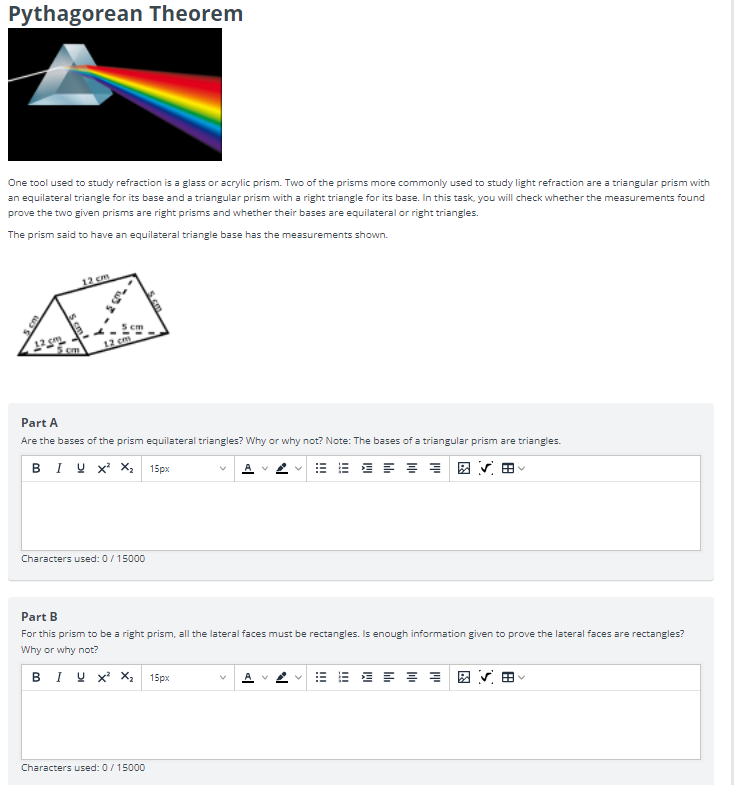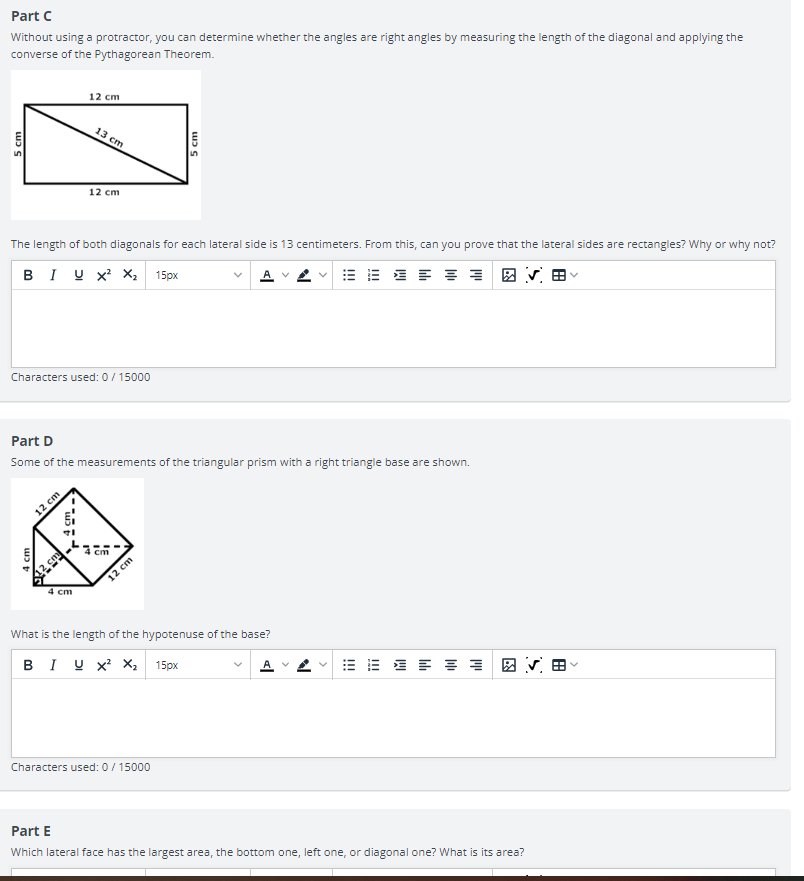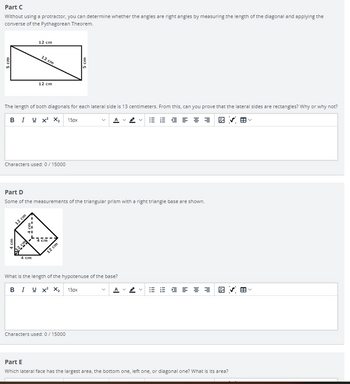ne tool used to study refraction is a glass or acrylic prism. Two of the prisms more commonly used to study light refraction are a triangular prism with n equilateral triangle for its base and a triangular prism with a right triangle for its base. In this task, you will check whether the measurements found rove the two given prisms are right prisms and whether their bases are equilateral or right triangles. he prism said to have an equilateral triangle base has the measurements shown. 12 cm 12 cm Part A Are the bases of the prism equilateral triangles? Why or why not? Note: The bases of a triangular prism are triangles. BIŲ X² X₂ 15px AVA Characters used: 0/15000 Part B For this prism to be a right prism, all the lateral faces must be rectangles. Is enough information given to prove the lateral faces are rectangles? Why or why not? BIU X² X₂ 15px A HEF Characters used: 0/15000 12.9
ne tool used to study refraction is a glass or acrylic prism. Two of the prisms more commonly used to study light refraction are a triangular prism with n equilateral triangle for its base and a triangular prism with a right triangle for its base. In this task, you will check whether the measurements found rove the two given prisms are right prisms and whether their bases are equilateral or right triangles. he prism said to have an equilateral triangle base has the measurements shown. 12 cm 12 cm Part A Are the bases of the prism equilateral triangles? Why or why not? Note: The bases of a triangular prism are triangles. BIŲ X² X₂ 15px AVA Characters used: 0/15000 Part B For this prism to be a right prism, all the lateral faces must be rectangles. Is enough information given to prove the lateral faces are rectangles? Why or why not? BIU X² X₂ 15px A HEF Characters used: 0/15000 12.9
Trigonometry (MindTap Course List)
8th Edition
ISBN:9781305652224
Author:Charles P. McKeague, Mark D. Turner
Publisher:Charles P. McKeague, Mark D. Turner
Chapter1: The Six Trigonometric Functions
Section: Chapter Questions
Problem 2GP
Related questions
Question
100%

Transcribed Image Text:Pythagorean Theorem
One tool used to study refraction is a glass or acrylic prism. Two of the prisms more commonly used to study light refraction are a triangular prism with
an equilateral triangle for its base and a triangular prism with a right triangle for its base. In this task, you will check whether the measurements found
prove the two given prisms are right prisms and whether their bases are equilateral or right triangles.
The prism said to have an equilateral triangle base has the measurements shown.
12 cm
12 cm
Part A
Are the bases of the prism equilateral triangles? Why or why not? Note: The bases of a triangular prism are triangles.
BIUX² X₂ 15px
A
Characters used: 0/15000
Part B
For this prism to be a right prism, all the lateral faces must be rectangles. Is enough information given to prove the lateral faces are rectangles?
Why or why not?
BIY X² X₂ 15px
V
≡ ≡ A V
Characters used: 0/15000
12 cm
N
bh

Transcribed Image Text:Part C
Without using a protractor, you can determine whether the angles are right angles by measuring the length of the diagonal and applying the
converse of the Pythagorean Theorem.
12 cm
5
12 cm
The length of both diagonals for each lateral side is 13 centimeters. From this, can you prove that the lateral sides are rectangles? Why or why not?
BIU X² X₂ 15px
E
Characters used: 0 / 15000
Part D
Some of the measurements of the triangular prism with a right triangle base are shown.
4 cm
4 cm
What is the length of the hypotenuse of the base?
BIU X² X₂ 15px
Characters used: 0 / 15000
Part E
Which lateral face has the largest area, the bottom one, left one, or diagonal one? What is its area?
5 cm
12 cm
4 cm.
4 cm
2
13 cm
12 cm
5 cm
N
>
田ㄣㄖ
Expert Solution
This question has been solved!
Explore an expertly crafted, step-by-step solution for a thorough understanding of key concepts.
This is a popular solution!
Trending now
This is a popular solution!
Step by step
Solved in 3 steps with 1 images

Follow-up Questions
Read through expert solutions to related follow-up questions below.
Follow-up Question
Need help with Part C D and E please. Question submitted as an image

Transcribed Image Text:Part C
Without using a protractor, you can determine whether the angles are right angles by measuring the length of the diagonal and applying the
converse of the Pythagorean Theorem.
12 cm
5
12 cm
The length of both diagonals for each lateral side is 13 centimeters. From this, can you prove that the lateral sides are rectangles? Why or why not?
BIU X² X₂ 15px
E
Characters used: 0 / 15000
Part D
Some of the measurements of the triangular prism with a right triangle base are shown.
4 cm
4 cm
What is the length of the hypotenuse of the base?
BIU X² X₂ 15px
Characters used: 0 / 15000
Part E
Which lateral face has the largest area, the bottom one, left one, or diagonal one? What is its area?
5 cm
12 cm
4 cm.
4 cm
2
13 cm
12 cm
5 cm
N
>
田ㄣㄖ
Solution
Recommended textbooks for you

Trigonometry (MindTap Course List)
Trigonometry
ISBN:
9781305652224
Author:
Charles P. McKeague, Mark D. Turner
Publisher:
Cengage Learning

College Algebra
Algebra
ISBN:
9781305115545
Author:
James Stewart, Lothar Redlin, Saleem Watson
Publisher:
Cengage Learning

Mathematics For Machine Technology
Advanced Math
ISBN:
9781337798310
Author:
Peterson, John.
Publisher:
Cengage Learning,

Trigonometry (MindTap Course List)
Trigonometry
ISBN:
9781305652224
Author:
Charles P. McKeague, Mark D. Turner
Publisher:
Cengage Learning

College Algebra
Algebra
ISBN:
9781305115545
Author:
James Stewart, Lothar Redlin, Saleem Watson
Publisher:
Cengage Learning

Mathematics For Machine Technology
Advanced Math
ISBN:
9781337798310
Author:
Peterson, John.
Publisher:
Cengage Learning,

Holt Mcdougal Larson Pre-algebra: Student Edition…
Algebra
ISBN:
9780547587776
Author:
HOLT MCDOUGAL
Publisher:
HOLT MCDOUGAL

Elementary Geometry For College Students, 7e
Geometry
ISBN:
9781337614085
Author:
Alexander, Daniel C.; Koeberlein, Geralyn M.
Publisher:
Cengage,

Glencoe Algebra 1, Student Edition, 9780079039897…
Algebra
ISBN:
9780079039897
Author:
Carter
Publisher:
McGraw Hill